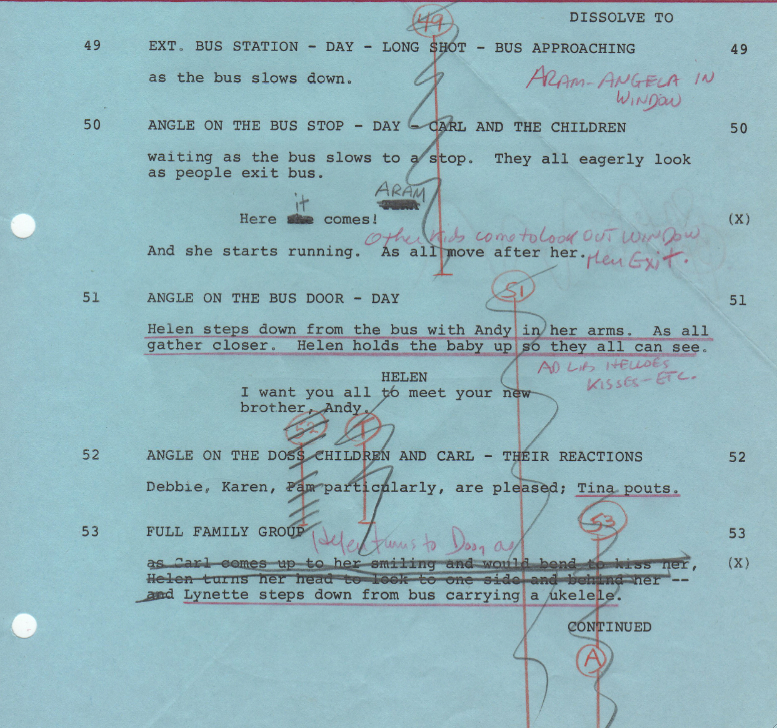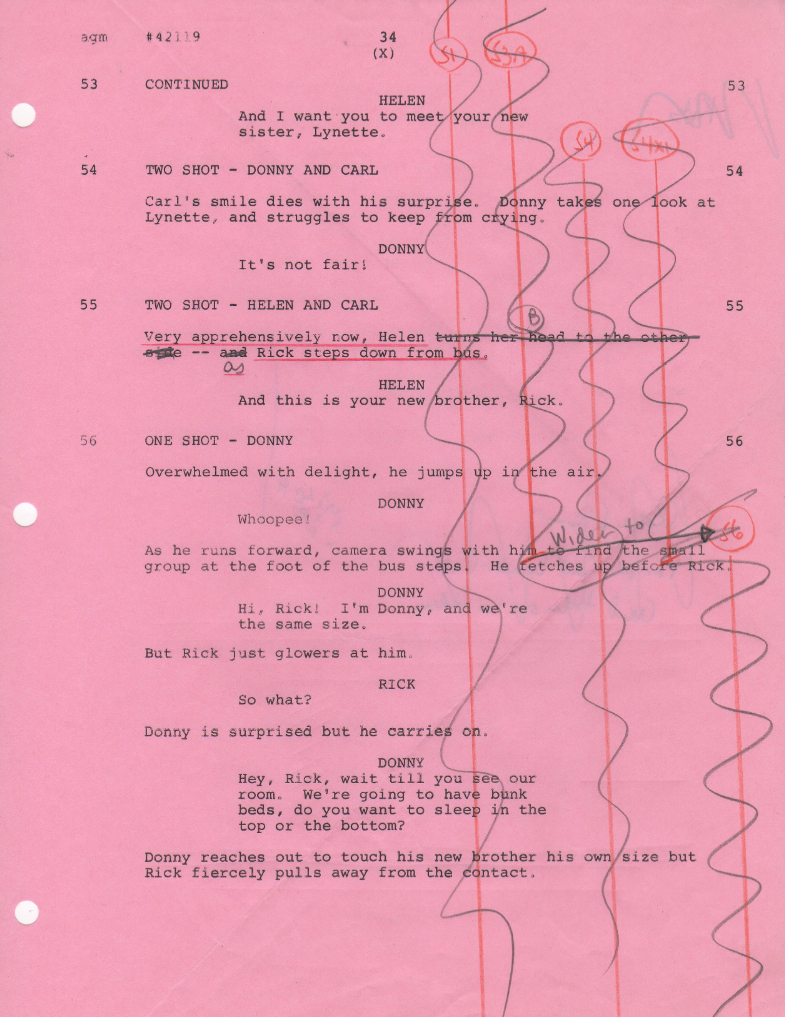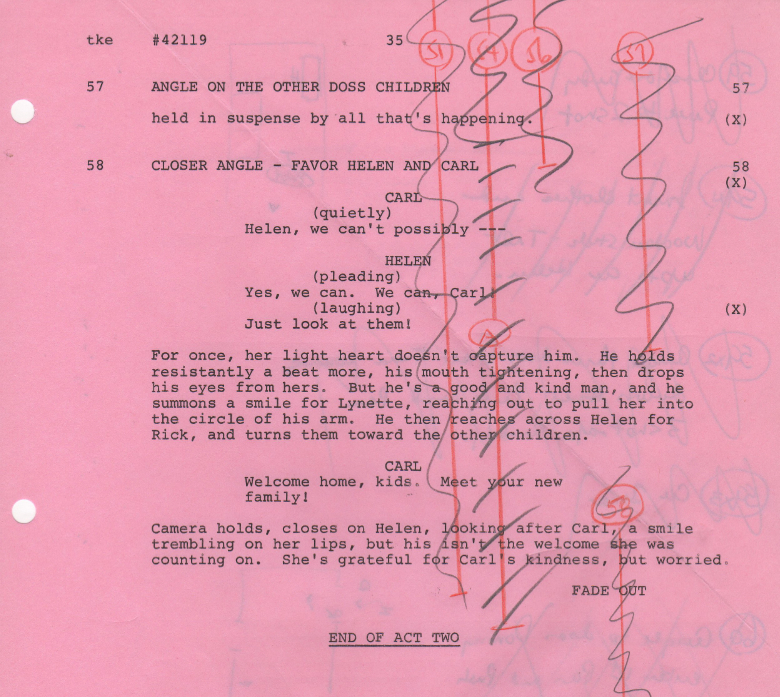FILMED December 1974
A year after completing A DREAM FOR CHRISTMAS I was back in the pulpit with another minister with a large family. I wonder if it was a coincidence that after directing the family oriented THE WALTONS in 1973, an ensuing assignment was THE FAMILY KOVACK, a movie-pilot based in Chicago, followed by THE FAMILY NOBODY WANTED. I don’t think so.
THE FAMILY NOBODY WANTED was a 1954 memoir by Helen Doss relating the story of how she and her husband, Carl Doss, a minister, adopted twelve unadoptable children. The book was adapted into a teleplay on PLAYHOUSE 90 in 1956; directed by John Frankenheimer it starred Lew Ayres and Nanette Fabray as the Doss couple. I was not involved with that production; I didn’t join the company until its second season. A further adventure of the Doss family was written in 1974 as a movie of the week. As you are about to find out, I was very involved with the later incarnation.
We went to Piru, a quaint small community north of Los Angeles (where nine years before I had filmed portions of WHEN THE WIND BLOWS, my last THE FUGITIVE) for the Doss family’s arrival in Franklinburg. But once they crossed the bridge, our small community of Franklinburg spread out a bit beyond the boundaries of Piru. The exterior of the church, which they pass, was in North Hollywood; the exterior of the parsonage was on the backlot of Universal Studio in Universal City, and finally the parsonage interior was on Stage 14 at the studio, as was the interior of the moving station wagon, which was filmed in poor man’s process. I made a major request of Jack Woolf, director of photography: on the shot of the interior of the moving car I wanted to see the faces of Carl, Helen and Donny in the front seat, but I wanted the kids in the back of the station wagon to be in silhouette. I wanted to save them for a special entrance.
Our first day we filmed the family’s arrival at the parsonage, but there was a last minute crisis. Casting director Reuben Cannon came down to the set to notify us that two of our children had dropped out. After some frantic phone calls to agents two new additions to our family arrived, Aram and Angela, the dark-haired boy and girl who were the first to enter the house.
This was another outing for Claudia Bryar (Eunice Franklin) and me. I had met Claudia and her husband, Paul Bryar (of whom I have already written extensively) in 1955 when they auditioned for a production of MY THREE ANGELS at the Players Ring Theatre in Hollywood. They performed in that play and the following year we again joined forces to do DEATH OF A SALESMAN at a theatre in Santa Monica.
When I was a student at the Pasadena Playhouse, there were five functioning theatres. Two of them — East Balcony and West Balcony –- were for productions cast only with second year students. The theatres were small, seating as I remember forty-five people. Each stage was equipped with a series of flats (wall units, doors, windows etc.) that were all painted slate gray. Each stage had a full complement of wooden block furniture (chairs, sofas, tables etc.) painted the same slate gray. The purpose for all this gray? Student actors and directors were being trained that they were responsible for establishing the ambience of the setting through performance. The stage on which we presented DEATH OF A SALESMAN at the Morgan Theatre in Santa Monica also was very small. Set designer Ruth Sofaer and I managed, following Jo Mielziner’s floor plan for the original Broadway production, to get the Loman kitchen with a stairway leading up to two bedrooms into that small area. Ideally I would have liked to have Willy and Linda’s bedroom on a platform at least four feet above the kitchen and the boys’ bedroom two feet higher, but the stage did not have that kind of height. Our final set had the parents’ bedroom just eighteen inches above the kitchen with the boys’ room an additional six inches higher. Why am I bringing this up? Judy Lewis, daughter of Loretta Young (whom I wrote about in my posting of SHADOW OF A STARLESS NIGHT on BREAKING POINT) came to see the show. Afterward we were standing on the stage in the kitchen area, and Judy said, “Where’s the big stairway?”
“What big stairway,” I asked.
“The stairway where Linda played the ‘attention must be played’ scene with Biff and Hap.”
I pointed to the spot at the top of our three-step stairway, just eighteen inches up from the kitchen floor. “That’s where she was standing.” The big stairway Judy had visualized was because of Claudia’s performance.
The Sunday church sequence was filmed on location the third day at the church in North Hollywood.
I had seen James Olsen in a production at the Ahmanson Theatre in Los Angeles. He was a powerhouse onstage in contrast to the rather bland actor I had considered him to be based on the roles he was given in films — feature and television. Working with him on this production, I realized his range was even greater than I had anticipated. Unfortunately I never worked with him again.
This was the first and again unfortunately the only time I worked with Woodrow Parfrey. Woody was noted for playing offbeat characters, roles to which he brought a quirky charisma. In this production his Elmer Franklin walked such a fine line. He is a racist, but what must be remembered is that this story takes place in 1947, just two years after the war with Japan ended. Elmer Franklin’s attitude to the children is difficult to condone, difficult to justify, but under the circumstances of his personal grief, I think it can at least be understood. What is more difficult for me is to realize that sixty-three years later, there are still so many Elmer Franklins around.
Did you know that Shirley Jones was named after child star Shirley Temple? THE FAMILY NOBODY WANTED was our eighth film together; I had directed Shirley in seven episodes of THE PARTRIDGE FAMILY. I think Shirley has had a remarkable career. At twenty-one she starred in the big-screen production of OKLAHOMA! She followed that by starring in two more screen musical classics, CAROUSEL and THE MUSIC MAN. She won an Academy Award for her dramatic performance as a prostitute in ELMER GANTRY. And with those illustrious credits she still is most remembered today for being Shirley, mother of THE PARTRIDGE FAMILY. On that show teenage idol David Cassidy got most of the attention and Danny Bonaduce got most of the funny lines, but I thought and think that it was Shirley with her warmth, her talent (she is a great actress and a marvelous singer) both before and behind the camera, who was the glue that held it all together.
In the posting of BULLY FOR YOU on THE COURTSHIP OF EDDIE’S FATHER I related an incident that taught me a valuable lesson. Jody Foster was guest starring as Joey, a six-year old tomboy. In a scene where she was to punch Eddie (Brandon Cruz) and then Eddie was to punch her, I instructed the two youngsters on how to pull their punches. No one was to get hit. When we did the take, Jody did her business without hitting Brandon, but when Brandon returned the punch, he actually hit Jody. Jody stopped, turned to the camera and with great comedy timing and delivery said, “He hit me.” Well I burst out laughing loudly as did the rest of the crew. Later in the editing room I realized had the take not been spoiled by the off camera laughter and my abrupt calling, “Cut,” I could have used the unexpected change in action by rewriting the following activity. In the present film we were doing a scene where something unexpected happened to little Tina. That time I had the presence of mind to protect the shot and restage the balance of the scene to use the accident that had occurred.
Ann Doran, the head of the orphanage, was another in that Hollywood army of performers who seemed to be in every other movie produced. During a career that spanned FIFTY-FOUR years (not counting a childhood appearance in a silent film) she acted in over five hundred films and a thousand television shows. She lived in Hollywood on the first street west of Ogden; her backyard abutted the backyard of Claudia Bryar, Mrs. Franklin in this production.
When a director prepared his director’s cut, if the film was long, he was not permitted to cut it down to size. This film was long when I turned my director’s cut over to the producer. Here is the script for the scene that followed the orphanage sequence.



I was stunned when I viewed the final cut. It was the final answer print and it was too late to make any additional changes. The return of Helen with THREE adoptees, what I considered an obligatory scene, had been eliminated. I felt there was a better way to solve the over length problem. The eliminated scene ran about two minutes. I know that two minutes could have been accomplished with trims throughout the show. It still comes as a shock to me when in the following scene Rick walks in with Donny. And poor Lynette gets lost; later when she does appear, the viewer can’t be blamed for not knowing who she is.
How to make a baby cry was another valuable lesson I learned and used. On A DREAM FOR CHRISTMAS a welfare worked came to my rescue when I had a happy baby but needed a crying baby. She told me that if a person made quiet crying sounds near the baby, the baby would empathetically respond by crying. What I learned when trying it was that the baby did not respond to my male voice doing the crying. So Shirley Jones became the surrogate crier. For the scene where she and Mrs. Bittner came into the laundry room, before the camera rolled Shirley would bend over the infant, make the required crying sounds, and when the baby had started to bawl, she would rush offstage, prepare herself for the scene while I would call for the camera to roll and when I said, “Action,” she and Mrs. Bittner rushed in and played the scene.
Our day of filming at the church location, we filmed a powerful scene between Shirley and James in one of the offices. This scene, late in the story, was filmed on the third day of a twelve-day schedule.
To be continued



I’m the youngest Doss girl. We have been looking for a complete copy of this movie for a long time. Please tell me how I can get a copy for my mother. Helen turned 97 this year. It would please her.
Diane
Diane: Send me the address at my e-mail: ralph@senensky.com and I will send it to you.
Ralph, Please, Please, Please let me know how I can get a copy of this movie! My name is David Borquez, and my fiancee is Dawn Biglay (she played Tina)! Let me give you the quick synopsis of our relationship. I met Dawn in the 4th grade and we were boyfriend and girlfriend as much as we could be then. (She was still acting and had done a couple Little House on the Priarie episodes and a couple pilots. Anyway, she moved away and I found her through her cousin my sophomore year of high school and we were together again until we graduated. I went into the Navy and she went on to college. During that time I tried several times to get back together with her but she wouldn’t have it. Long story short, I got married and lived in Florida for 18 years, and she got married and lived in Arizona. We both went thru divorces and got in touch with one another February 2011, and saw each other in person for the first time in May 2011. I proposed the first night we were together. We are the definition of ‘Soul Mates’ and I would love to give this to her as a wedding present. We are getting married this New Year’s Eve. Please let me know. Thank you, David Borquez
Wow, I finally learned how you guys got a baby to cry! I have always wondered how that was done, since I knew you probably didn’t injure a baby to make it cry. Amazing in a way, to think that human empathy develops that soon after we’re born (too bad so many of us lose it).